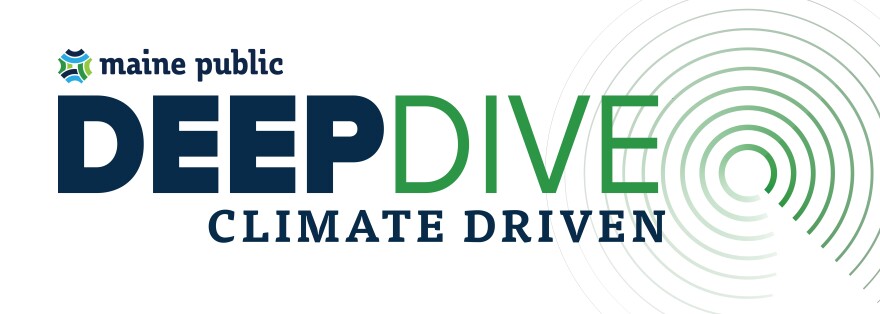Two years ago, the United Nations Secretary General declared that the climate crisis is a code red for humanity. Antonio Guterres also noted that every day dozens of species are going extinct.
How this planetary emergency plays out is unclear. But a new exhibit at the Maine Historical Society in downtown Portland offers clues based on the way humans have disrupted the environment in the past. The exhibit also shows why indigenous knowledge is considered an essential guide for the path ahead.
In the Dawnland, the Wabanaki homeland that makes up what is now referred to as the state of Maine, there's a creation story that Passamaquoddy knowledge-keeper Gabriel Frey says is centered around a benevolent culture hero, Glooscap and the black ash tree.
"Before the Wabanaki were here, in the Dawnland, Glooscap fired an arrow into the ash tree and when the tree split open the Wabanaki came out along with a lot of other forest spirits...basically here to steward the land," Frey says.

This story is part of our series "Climate Driven: A deep dive into Maine's response, one county at a time."
Ash is a keystone species for the Wabanaki — the Passamaquoddy, Penobscot, MicMac and Maliseet tribes — who've been using it to make baskets for thousands of years. And Frey, who describes himself as a 13th generation artisan, has created a basket that's on display in the Maine Historical Society's CODE RED exhibit. His mother, Gal Frey, did the intricate beadwork.
Made of ash at the base, the distinctive basket is pure white and signifies a snowy owl. Co-curator Tilly Laskey says it's an important symbol for the exhibit and for human caused climate change.

"The ash tree might now be in Maine for, you know, the next generations of Wabanaki people to be able to make these baskets...just like the snowy owl itself has had to move further north to find the prey to exist," says Laskey.
Without enough prey in the Arctic, Laskey says, the snowy owl might go extinct. Ash trees are threatened by the emerald ash borer, an invasive insect that has killed hundreds of millions of them so far. How humans have changed the environment is one focus of the CODE RED exhibit.
The other is on Indigenous wisdom. Indigenous people make up 4% of the world's population and steward 80% of the biodiversity on just 20% of the land base. That's why the UN secretary general says they "hold many of the solutions to the climate crisis.
Dr. Darren Ranco, co-curator of the exhibit, echoes that view.
"Land trusts and conservation groups are recognizing that Indigenous peoples' participation, decision making, authority in conservation work around the globe leads to the best outcomes for biodiversity and other ways of measuring conservation," Ranco says.
Ranco is a citizen of the Penobscot Nation and a professor of anthropology at the University of Maine. Speaking to an online audience about CODE RED, Ranco said he believes caretaking will be key to survival on the planet.
"The teaching, of course, from Wabanaki people is this notion that we take care of it, it takes care of us."

That also means, Ranco says, that humans are not separate from nature, nor are Indigenous and non-Indigenous people separate from each other. But history and the CODE RED exhibit reveal many examples of how this has not been the case in the past. Some of the objects in the collection come from the now-defunct Portland Society of Natural History. Founded in the 1800s, the society did not see Wabanaki people as human and so Ranco says his ancestors and their creations were showcased alongside the fossils of long extinct animals. And this, he says, reflects a specific world view.
"One that has created the crisis, we as humanity face, with climate change," Ranco says.
Tilly Laskey says changes to the natural world are in sharp focus in Maine right now, affecting the economy and culture.


"And so this show is really timely...being able to discuss the historical aspects of climate change and biodiversity loss and really trying to get people to imagine a different future," Laskey says.
Passamaquoddy basketmaker Gabriel Frey, who's been visiting, stewarding and harvesting the same stands of ash trees since he was a child, says he has hard time imagining a future where his two young daughters no longer have ash to make baskets. It's not just the art form that will be lost, he says, but also the connection to the trees that grow with you.
"My children will be the first in a thousand years to not pass this cultural practice on to their children. It's heavy, but it's the reality that we're living in," Frey says.
Frey's snowy owl basket is now part of the Maine Historical Society's permanent collection. The birds are a relatively rare sight in Maine, which is toward the bottom of their territory. But Frey says, like the ash, the snowy owl is important in Passamaquoddy culture, almost like a medicine keeper.
"And when our mythical figure, Glooscap left the people, the snowy owl went into the deep forest where he wasn't seen for a very long time," Frey says.
Frey says some view the snowy owl as a representation of death but he was always taught that it is a messenger of change. As for going into the deep woods, he says in his view that's about solitude, grief, and restoration.
The CODE RED exhibit at the Maine Historical Society runs through Dec. 30.




